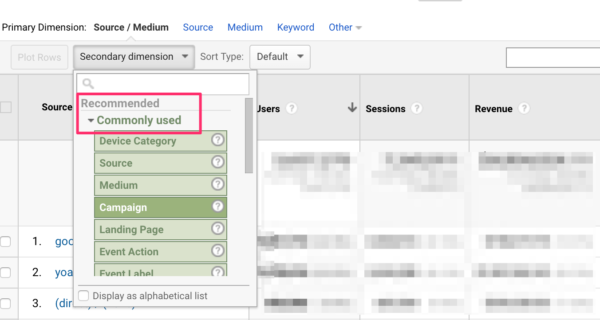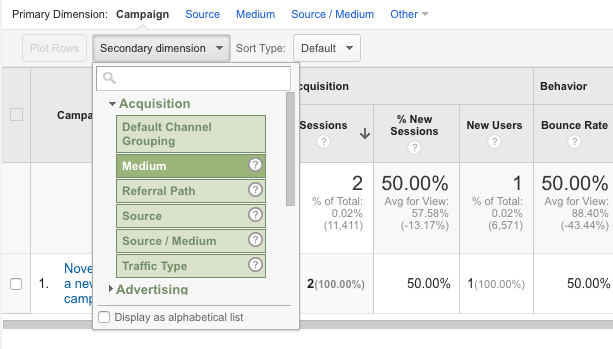Deciphering the Relevance of Second Measurement in Google Analytics: All Regarding Its Value and Effect
In the realm of electronic analytics, the use of secondary dimensions within Google Analytics functions as an essential device for discerning deeper layers of data insights. The value of additional dimensions depends on their capability to provide a nuanced view of customer actions and communication with a site or platform. By dissecting information past surface-level metrics, companies can open a wide range of info that forms tactical decisions and improves marketing initiatives. This exploration right into the world of second measurements not only provides a comprehensive understanding of individual interaction but likewise clarifies the intricate characteristics that drive online efficiency.
Comprehending Secondary Measurements in Google Analytics
The understanding of secondary dimensions in Google Analytics is crucial for gaining deeper insights right into user behavior and web site performance. While key measurements give basic information points such as traffic sources and web page sights, additional dimensions permit a more nuanced analysis by providing extra context to these primary metrics. By incorporating secondary dimensions, users can sector and filter their data to uncover patterns and patterns that may not be promptly obvious.

Revealing the Benefits of Second Measurements
Building upon the fundamental understanding of secondary measurements in Google Analytics, exploring the advantages they supply exposes invaluable insights for improving information evaluation and decision-making. By integrating secondary dimensions, individuals can delve deeper right into their data, obtaining an extra extensive view of individual behavior, content efficiency, and other vital metrics. One of the primary advantages is the ability to section information, permitting a much more granular evaluation of various measurements such as website traffic resources, gadgets, demographics, and much more. This segmentation makes it possible for users to identify patterns, fads, and connections that might not be evident when looking at data in accumulation.
Additionally, additional dimensions offer context to primary data, providing added layers of details that can aid in comprehending individual communications and choices. This enhanced understanding can guide strategic decision-making, resulting in even more targeted advertising campaigns, web site optimizations, and overall better performance. Fundamentally, second dimensions serve as an effective tool for opening much deeper insights and making best use of the energy of Google Analytics for businesses and internet site proprietors.
Leveraging Secondary Measurements for Boosted Insights
By utilizing the power of secondary dimensions in Google Analytics, companies can discover deeper understandings that drive educated critical and decision-making optimization initiatives. Leveraging additional dimensions permits businesses to dig past surface-level data and obtain a much more extensive understanding of individual behavior, audience demographics, traffic sources, and web site efficiency. By incorporating primary measurements like web traffic resources with additional measurements such as geographical area or gadget group, businesses can recognize which areas or tools are driving the most beneficial web traffic to their website.
In addition, secondary measurements allow companies to sector and evaluate data better, helping them recognize patterns, patterns, and chances that might have or else gone undetected. By making use of secondary dimensions, businesses can tailor their advertising approaches, content, and individual experience to much better satisfy the demands and choices of their target audience. Basically, leveraging secondary dimensions in Google Analytics equips organizations to make data-driven choices that lead to improved efficiency, enhanced ROI, and sustainable growth.

Effect of Second Dimensions on Information Evaluation
Enhancing data analysis via the use of secondary measurements in Google Analytics provides companies with a deeper understanding of their on-line efficiency metrics. By integrating secondary measurements, such as time of day, geographical place, or device category, services can discover important understandings that might have been overlooked with main dimensions alone. This boosted degree of granularity allows for more accurate division of information, making it published here possible for organizations to identify patterns, trends, and relationships that can drive calculated decision-making.

Optimizing Potential: Second Capacities Strategies
One crucial method is to combine secondary dimensions with key dimensions to obtain a detailed sight of user interactions. Matching the key measurement of 'source/medium' with secondary measurements like 'landing page' or 'gadget category' can disclose which networks are driving traffic to specific web pages or exactly how customer habits differs throughout devices.
Additionally, using second measurements to segment read this article data based on individual demographics, actions, or innovation can aid organizations tailor their advertising initiatives to certain audience sections. This targeted approach can lead to enhanced conversion prices, enhanced customer experiences, and eventually, enhanced ROI. By making best use of the capacity of secondary measurements in Google Analytics, companies can make educated choices, enhance their on-line visibility, and drive sustainable development.
Final Thought
To conclude, secondary measurements in Google Analytics play a vital role in providing much deeper understandings and enhancing data evaluation. By utilizing additional dimensions efficiently, businesses can get a much more comprehensive understanding of individual actions and web site performance. Integrating secondary measurements right into information evaluation techniques can result in more informed decision-making and boosted general performance. It is necessary for services to leverage the power of additional dimensions to maximize their potential and accomplish better success in their on-line undertakings (what is a “secondary dimension” in google analytics?).
While main measurements supply essential information factors such as web traffic sources and page sights, secondary measurements allow for a more nuanced analysis by supplying added context to these main metrics. By incorporating key measurements like web traffic resources with additional measurements such as geographic place my response or gadget classification, organizations can identify which regions or devices are driving the most valuable website traffic to their internet site.
By including additional measurements, such as time of day, geographic location, or device category, businesses can reveal useful understandings that may have been ignored with main dimensions alone. One key strategy is to incorporate second measurements with main measurements to obtain a detailed sight of user interactions. Combining the main measurement of 'source/medium' with secondary measurements like 'touchdown page' or 'tool category' can reveal which channels are driving website traffic to details pages or just how customer actions varies throughout gadgets.